

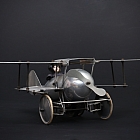
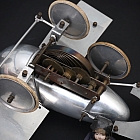
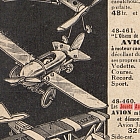
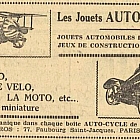
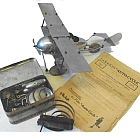
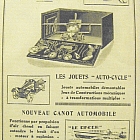
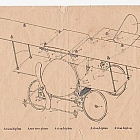
AUTOCYCLE AERONEF BIPLAN ALUMINIUM 1930 ET SON RARE PILOTE TETE PORCELAINE
Antique toys from .
Auto-Cycle
All-aluminium march!
At the beginning of the 1920s, the country's economic conditions were very favourable. In about ten years, between the end of the First World War and the 1929 crisis, industrial production quadrupled, driven by the needs of reconstruction, progress in science and technology and mechanization in particular. In this context, aluminium, whose cost fell more than all other metals, experienced considerable growth. It would thus supplant many of them, and in particular copper, in the manufacture of a multitude of everyday objects and utensils, including toys.
The first Auto-Cycle boxes were presented in the Spring 1920-1921 New Year's catalogue.
Mechanical construction toys with multiple transformations
The Roquefort-Villeneuve & Cie company, founded in 1920, specializes in the creation of aluminum construction games that are marketed under the name Auto-Cycle. The company has a head office located at 77 rue du Faubourg St-Jacques in Paris and a manufacturing workshop established at 39 rue Darreau in the 14th arrondissement.
.
The precursor to Meccano?
The first box set offered is available in five sizes. Depending on the number of pieces contained, it was possible to build different models whose assembly difficulty increased depending on whether it was a question of making a tricycle or a motorcycle with box No. 1, a three-wheeler with box No. 2, all these combinations plus a bicycle with box No. 3, a motorcycle hitched to a wicker basket or an all-aluminium three-wheeler with box No. 4. As for box No. 5, the most complete, it allowed to obtain all the aforementioned models and a few others including a beautiful scooter. Box No. 6 included three fully assembled models, the wicker sidecar motorcycle, the scooter and the three-wheeler.
A spring motor, delivered assembled or to be assembled according to the instructions in a manual, was provided to animate these models and test the ingenuity of the young Meccano enthusiasts. These well-made, all-aluminum clockwork mechanisms were hidden in the couplings.
The Roquefort-Villeneuve company was declared bankrupt in August 1924, leaving its plans for a car, a plane and other vehicles in the pipeline. The Fontaine, Rigot & Cie company, located at 127 rue du Vieux-Pont-de-Sèvres in Boulogne-Billancourt (92), took over the brand in 1930. The name Auto-Cycle was retained and would remain stamped on each model.
Car and planes to assemble
The production of Auto-Cycle models continued while expanding with remarkable new features: a car with geometric lines and two planes. At the end of production, sicalite (hard plastic material) would be offered as an alternative to aluminum for sidecars and planes.
In total, under its new corporate name Fontaine-Rigot, the Auto-Cycle catalog will include four disassemblable toys with mechanical engines: motorcycle with sidecar, three-wheeler, airplane and automobile. To which will be added six boxes of mechanical construction games with multiple transformations (from 12 to 37 combinations). Boxes No. 3 and following, presented in the “Luxe” version, benefited from a wooden case. The spare parts were available at retail until the end of Auto-Cycle’s activities in 1938.
Auto-Cycle toys and games are not easy to find, or quite rare complete, or in box, with their instructions. They are popular with collectors of old toys, but also with motorcycle and two-wheel enthusiasts who are looking for them. A beautiful example can be exchanged from €300.
Martine Hermann and Giuseppe Scarani
(Photos and collection © G. Scarani)
These search criteria may interest you:
. ART DECOANTIQUE TOYSAIRPLANE AND AEROSTAAERONAUTICRETROMOBILE SHOW FEBRUARY 2025ART DECO OBJECTSVARIOUS TOYSFOCUS




WWW.MASTERPOSTERS.COM
By ESTAMPE MODERNE & SPORTIVE
7 RUE MILTON - 16 RUE CHORON 75009 PARIS
(+33) (0)1 42 80 01 03








